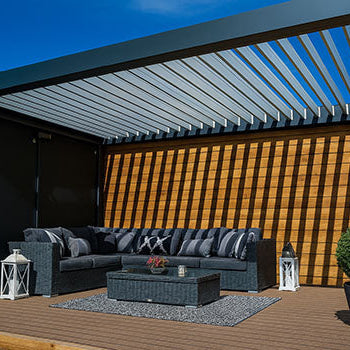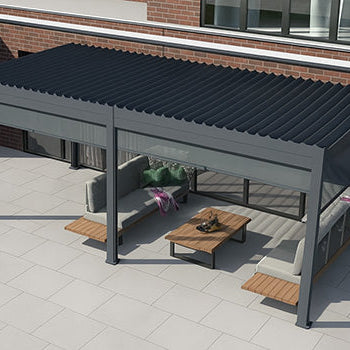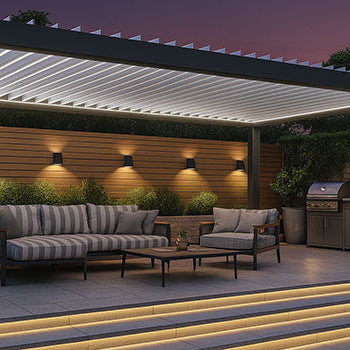Thinking of adding a pergola but worried it's a legal land anchor? You're not alone. Short answer: Pergolas can be permanent, but it depends on how you build them. From cheeky DIY setups to concrete-anchored statements, keep reading to decode the rules, the red tape, and whether your pergola project needs planning permission or not.

Defining "Permanent Structure" in a UK Planning Context
What Makes a Structure "Permanent" vs. "Temporary"?
Let’s keep it simple: a permanent structure is something you can’t just pick up and move. It’s designed to stay put for years, think concrete posts, solid foundations, and being fixed to your home or land.
A temporary structure, on the other hand, is more like a garden tent. You might pop it up for summer BBQs and pack it away when the weather turns. The difference isn’t just about how long it lasts, but how it's installed.
Planning officials look at how easily something can be removed. If it’s built in a weekend and can be dismantled in a day, it’s probably temporary.
But bolt it to your patio or sink posts in concrete? That’s when things start getting “permanent.”
The Importance of Foundations and Anchoring
Here's the kicker, how your pergola is anchored is a big deal.
If it’s just sitting on paving stones with some weight to keep it from flying off in the wind, planners may see it as temporary. But once you start using concrete footings or bolting it into your decking, it becomes part of your property in the eyes of the law.
The deeper it's dug in, the harder it is to argue it’s temporary.
Why This Classification Matters for Planning Rules
The moment your pergola is considered permanent, it triggers a different set of rules. You may need to apply for planning permission, especially if it’s:
In short: permanence comes with paperwork. That’s why knowing where your build stands (literally and legally) is so important.
How UK Planning Law Classifies Pergolas
Pergolas as "Outbuildings" Under Permitted Development
In many cases, pergolas are treated like garden sheds or greenhouses—they fall under “permitted development” rules. That means you don’t always need to apply for permission if you stick to certain conditions.
Generally speaking, you’re in the clear if:
-
The pergola isn’t higher than 2.5 metres
-
It doesn’t take up more than half your garden
-
It’s not in front of your home’s main elevation
This means pergolas can be added without drama, but only if you follow the rules.
When a Pergola is Considered a Permanent Fixture
Let’s say you build a pergola with chunky timber posts, sink them in concrete, and connect it to your patio with integrated lighting. That’s not just a “nice garden touch”, that’s a permanent structure.
It’s not just what it looks like, but how it functions and how it’s installed. The more fixed and complex it becomes, the more likely it is to be considered permanent by your local planning office.
How a Roof or Foundations Changes the Classification
Here’s a real-life twist: your simple pergola becomes a different beast once you add a roof. Especially if it’s made from polycarbonate panels, wood, or tiles.
A solid roof creates a more defined space, adds weatherproofing, and often pushes the build beyond what's classed as “temporary.”
Foundations and roofing are the two biggest triggers for a pergola being treated like a permanent addition to your home.

Key Factors That Determine if a Pergola is Permanent
The Method of Construction (e.g., Concrete Footings vs. Freestanding)
So, are pergolas freestanding, or do they need to be fixed down? Actually, they can be either.
Freestanding pergolas that use simple weighted bases or surface anchors are more flexible and often seen as temporary. But if your pergola involves digging holes and pouring concrete, you've crossed into permanent territory.
Think of it like pitching a tent versus laying bricks, you know which one’s going to be harder to take down.
The Size and Scale of the Structure
Size matters, at least when it comes to planning. A compact wooden frame tucked into a garden corner might slide under the radar.
But if you build a grand structure spanning your patio with a roof and built-in seating, expect more scrutiny.
Larger pergolas are more visible, more permanent-looking, and more likely to need permission.
The Degree of Attachment to the Ground or Main Dwelling
Now, this is a big one. Are pergolas attached to a house? Can pergolas be freestanding? Yes and yes, but the attachment is what often tips the scales.
A pergola bolted to your home becomes a structural extension. Even if it’s open-sided, it’s part of the architecture now.
Is it OK to attach a pergola to a house? It usually is, but once it’s fixed, local councils may consider it permanent and require permission.
The Intended Lifespan of the Structure
If you’re building a pergola to last a decade or two, it’ll show in the design and materials. Pressure-treated wood, aluminium frames, or heavy-duty fixings all signal long-term use.
Planners take that into account. Your intention matters, and permanent-looking builds often get permanent treatment under the law.
Implications of a Pergola Being a Permanent Structure
Impact on Planning Permission Requirements
If your pergola is classed as permanent, you’ll likely need to apply for planning permission, especially if:
Skipping this step can mean fines or being told to take the structure down, not fun after all that hard work.
Relevance for Home Insurance Policies
Here’s something many homeowners miss: a permanent pergola might need to be declared to your insurance provider.
Why? Because it becomes part of your property. If a storm takes the roof off or a falling branch causes damage, your claim might be denied if the pergola wasn’t listed.
Always check the fine print.
Considerations When Selling Your Home
Thinking of moving one day? A permanent pergola with no planning approval can raise eyebrows during surveys.
Buyers, or more likely, their solicitors, might flag it, and that can slow things down. Having the proper paperwork can help avoid delays and price reductions.
How it Affects Building Near a Boundary Line
Placing a pergola close to your boundary? That’s where it gets tricky.
Permanent structures near property lines can cause disputes, especially if they block light or create privacy concerns. Always check how close you’re allowed to build and, if needed, chat with your neighbours beforehand.

Frequently Asked Questions
Is a DIY pergola kit from a shop considered permanent?
Most DIY pergola kits are designed to be lightweight and freestanding. As long as you follow the instructions and don’t fix it into concrete or attach it to your home, it’ll likely be seen as temporary.
But once you anchor it or upgrade it with roofing, it starts looking more like a fixture.
Does adding a polycarbonate roof make a pergola a permanent structure?
Yes, in most cases. A solid roof turns your pergola into a weatherproof shelter, and that significantly changes how it’s classified.
It’s now more of a structure than a garden feature, and that means planning rules apply.
Are there temporary pergola options available?
Definitely! You’ll find plenty of freestanding, moveable pergolas in garden centres or online. Some come with fabric tops or collapsible frames, perfect for summer events or renters.
They offer shade without the commitment, and best of all? No planning headaches.









